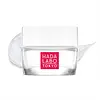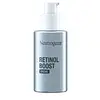What's inside
What's inside
 Key Ingredients
Key Ingredients

 Benefits
Benefits

 Concerns
Concerns

 Ingredients Side-by-side
Ingredients Side-by-side

Water
Skin ConditioningDipropylene Glycol
HumectantGlycerin
HumectantPentylene Glycol
Skin ConditioningButylene Glycol
HumectantPEG-240/Hdi Copolymer Bis-Decyltetradeceth-20 Ether
StabilisingPPG-17-Buteth-17
Skin ConditioningTriethylhexanoin
MaskingPEG-8
HumectantSorbitol
HumectantPolysorbate 60
EmulsifyingInositol
HumectantPhenoxyethanol
PreservativePropanediol
SolventSorbitan Sesquioleate
EmulsifyingSodium Citrate
BufferingBeheneth-30
CleansingPolyacrylate Crosspolymer-11
Emulsion StabilisingHydrolyzed Hyaluronic Acid
HumectantLactobacillus/Soymilk Ferment Filtrate
Skin ConditioningDisodium EDTA
Citric Acid
BufferingCaprylhydroxamic Acid
Sodium Acetylated Hyaluronate
HumectantPropylene Glycol
HumectantSodium Hyaluronate
HumectantPotassium Laurate
EmulsifyingTocopherol
AntioxidantAlcohol Denat.
AntimicrobialPanax Ginseng Root Extract
EmollientSodium Hyaluronate Crosspolymer
HumectantHydroxyacetophenone
AntioxidantSodium Chloride
MaskingWater, Dipropylene Glycol, Glycerin, Pentylene Glycol, Butylene Glycol, PEG-240/Hdi Copolymer Bis-Decyltetradeceth-20 Ether, PPG-17-Buteth-17, Triethylhexanoin, PEG-8, Sorbitol, Polysorbate 60, Inositol, Phenoxyethanol, Propanediol, Sorbitan Sesquioleate, Sodium Citrate, Beheneth-30, Polyacrylate Crosspolymer-11, Hydrolyzed Hyaluronic Acid, Lactobacillus/Soymilk Ferment Filtrate, Disodium EDTA, Citric Acid, Caprylhydroxamic Acid, Sodium Acetylated Hyaluronate, Propylene Glycol, Sodium Hyaluronate, Potassium Laurate, Tocopherol, Alcohol Denat., Panax Ginseng Root Extract, Sodium Hyaluronate Crosspolymer, Hydroxyacetophenone, Sodium Chloride
Water
Skin ConditioningPentaerythrityl Tetraethylhexanoate
EmollientDimethicone
EmollientGlycerin
HumectantPPG-15 Stearyl Ether
EmollientStearyl Alcohol
EmollientCetearyl Alcohol
EmollientButylene Glycol
HumectantCeteareth-20
CleansingIsohexadecane
EmollientRetinol
Skin ConditioningHydrolyzed Myrtus Communis Leaf Extract
Skin ProtectingCaprylic/Capric Triglyceride
MaskingEthylhexylglycerin
Skin ConditioningSodium Hyaluronate
HumectantCaprylyl Glycol
EmollientPolyacrylamide
Cellulose
AbsorbentC13-14 Isoparaffin
EmollientLaureth-7
EmulsifyingDimethicone Crosspolymer
Emulsion StabilisingAmmonium Acryloyldimethyltaurate/Vp Copolymer
Disodium EDTA
Sodium Hydroxide
BufferingBHT
AntioxidantAscorbic Acid
AntioxidantPhenoxyethanol
PreservativeChlorphenesin
AntimicrobialParfum
MaskingWater, Pentaerythrityl Tetraethylhexanoate, Dimethicone, Glycerin, PPG-15 Stearyl Ether, Stearyl Alcohol, Cetearyl Alcohol, Butylene Glycol, Ceteareth-20, Isohexadecane, Retinol, Hydrolyzed Myrtus Communis Leaf Extract, Caprylic/Capric Triglyceride, Ethylhexylglycerin, Sodium Hyaluronate, Caprylyl Glycol, Polyacrylamide, Cellulose, C13-14 Isoparaffin, Laureth-7, Dimethicone Crosspolymer, Ammonium Acryloyldimethyltaurate/Vp Copolymer, Disodium EDTA, Sodium Hydroxide, BHT, Ascorbic Acid, Phenoxyethanol, Chlorphenesin, Parfum
Ingredients Explained
These ingredients are found in both products.
Ingredients higher up in an ingredient list are typically present in a larger amount.
Butylene Glycol (or BG) is used within cosmetic products for a few different reasons:
Overall, Butylene Glycol is a safe and well-rounded ingredient that works well with other ingredients.
Though this ingredient works well with most skin types, some people with sensitive skin may experience a reaction such as allergic rashes, closed comedones, or itchiness.
Learn more about Butylene GlycolDisodium EDTA plays a role in making products more stable by aiding other preservatives.
It is a chelating agent, meaning it neutralizes metal ions that may be found in a product.
Disodium EDTA is a salt of edetic acid and is found to be safe in cosmetic ingredients.
Learn more about Disodium EDTAGlycerin is already naturally found in your skin. It helps moisturize and protect your skin.
A study from 2016 found glycerin to be more effective as a humectant than AHAs and hyaluronic acid.
As a humectant, it helps the skin stay hydrated by pulling moisture to your skin. The low molecular weight of glycerin allows it to pull moisture into the deeper layers of your skin.
Hydrated skin improves your skin barrier; Your skin barrier helps protect against irritants and bacteria.
Glycerin has also been found to have antimicrobial and antiviral properties. Due to these properties, glycerin is often used in wound and burn treatments.
In cosmetics, glycerin is usually derived from plants such as soybean or palm. However, it can also be sourced from animals, such as tallow or animal fat.
This ingredient is organic, colorless, odorless, and non-toxic.
Glycerin is the name for this ingredient in American English. British English uses Glycerol/Glycerine.
Learn more about GlycerinPhenoxyethanol is a preservative that has germicide, antimicrobial, and aromatic properties. Studies show that phenoxyethanol can prevent microbial growth. By itself, it has a scent that is similar to that of a rose.
It's often used in formulations along with Caprylyl Glycol to preserve the shelf life of products.
Sodium Hyaluronate is hyaluronic acid's salt form. It is commonly derived from the sodium salt of hyaluronic acid.
Like hyaluronic acid, it is great at holding water and acts as a humectant. This makes it a great skin hydrating ingredient.
Sodium Hyaluronate is naturally occurring in our bodies and is mostly found in eye fluid and joints.
These are some other common types of Hyaluronic Acid:
Learn more about Sodium HyaluronateWater. It's the most common cosmetic ingredient of all. You'll usually see it at the top of ingredient lists, meaning that it makes up the largest part of the product.
So why is it so popular? Water most often acts as a solvent - this means that it helps dissolve other ingredients into the formulation.
You'll also recognize water as that liquid we all need to stay alive. If you see this, drink a glass of water. Stay hydrated!
Learn more about Water